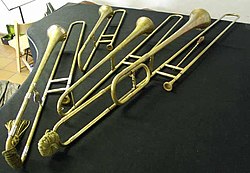Sackbut
The sackbut is a brass musical instrument from the Renaissance. By the 1750s, it was developing into the modern trombone.[1] It has narrower tubing, does not have a water key, a slide lock or a tuning slide that are found on trombones.[2] It is played by buzzing the lips into a mouthpiece. The length of the instrument could be changed by the use of a sliding tube which meant it could play a full chromatic range of notes. The earliest instruments come from the 1500's. The sackbut was popular because it could be played loudly or softly, and it could also be played in tune. They were made in a range of sizes, a descant (rarely used), alto, tenor and bass. They were often played to accompany a church choir.[3]
 Sackbuts | |
| Classification | Brass |
|---|---|
| Related instruments | |
| Trombone | |
Sackbut Media
Left to right: replica alto, tenor and bass sackbuts, in Museu de la Música de Barcelona.
Trombones in Syntagma Musicum (1614-20), by Michael Praetorius.
A re-created wait, an ensemble of loud instruments suited to playing outdoors. Centre, a sackbut.
References
| Wikimedia Commons has media related to Lua error in Module:Commons_link at line 62: attempt to index field 'wikibase' (a nil value).. |
- ↑ "The World of the early sackbut player: flat or round? -- McGowan XXII (3): 441 -- Early Music". em.oxfordjournals.org. Retrieved 2009-06-19.
- ↑ "The Sacbut". www.music.iastate.edu. Archived from the original on 2016-05-04. Retrieved 2009-06-19.
- ↑ Montagu, Jeremy (1976). The World of Medieval and Renaissance Musical Instruments. Sydney: Ure Smith. p. 104. ISBN 0725403144.




